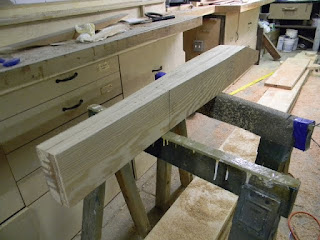I did get it in place, but not without a great deal more effort and back strain than I intended. I pushed it out the basement window onto the driveway (a good dry run for moving the mast out of the basement sometime in the future) and set it on a mover's dolly to roll it back to the garage. Lifting one end at a time, I got it onto the hull.
The position is important here. According to the plan, the bottom of the keel is supposed to be about about 3" farther from the waterline at the stern than it is where it begins its curve forward of the centerboard slot, so the long section, which will define the final contour of the keel needed to be set in place off-level before scribing.
After scribing the curve of the hull onto the keel section, I lowered it onto a couple of sawhorses, and powerplaned down to the scribed line. A band saw would have made the process a lot easier, but feeding that big a board through the band saw alone would have been impossible. Two trips between the hull and the sawhorses, and I had a pretty fair match.
I also shaped the taper at the forward and aft end using the power plane, and I will finalize that and blend it into the stem and stern after the keel is glued up and in place.
| The 16 foot section of keel in place after shaping |
 | |
| Glued up section for where keel joins to stem. |
 |
| Deadwood section to sit aft of lead ballast will go on later |
Nicely done! Envious that you are building a Grey Seal. Hope to do it myself one day.
ReplyDelete